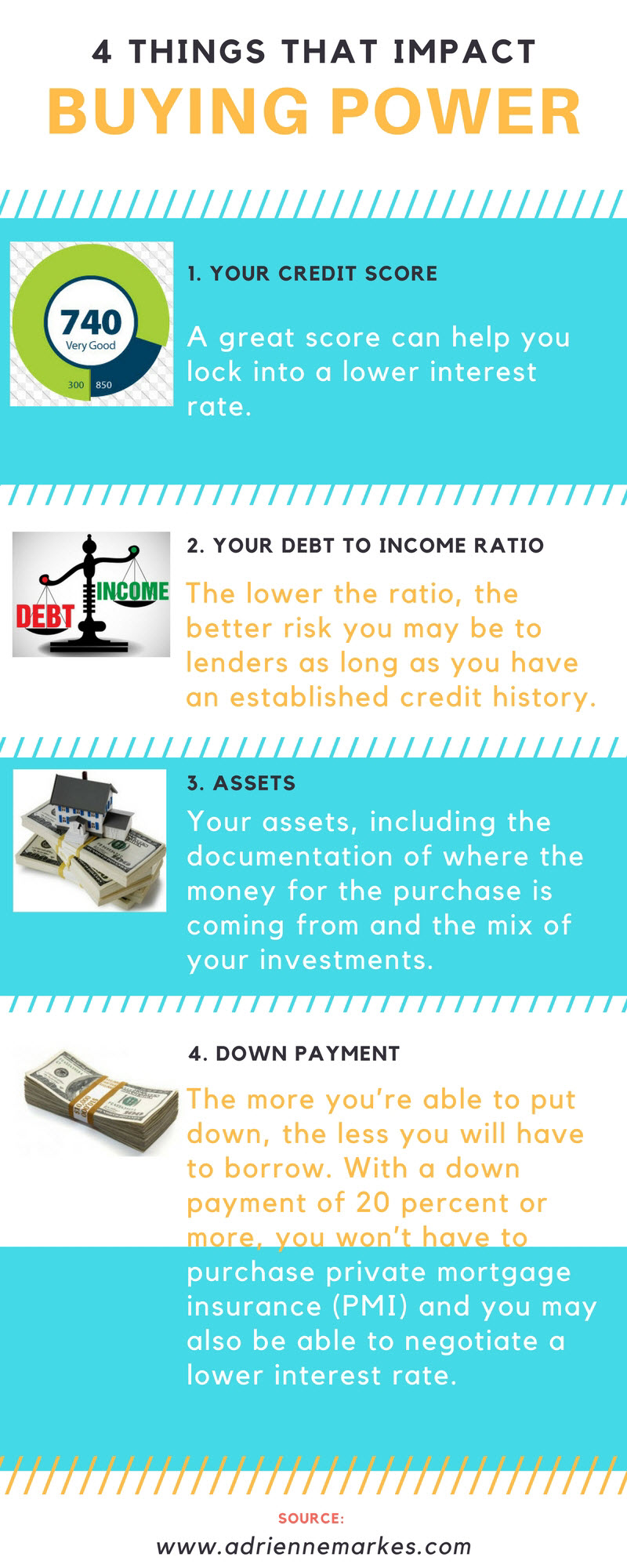- 714.396.2819
- Email Me
- My Dashboard
Advanced Search
What the Heck is Home Buying Power?
 You may have heard the term “Home buying power”, but what does it mean exactly?
You may have heard the term “Home buying power”, but what does it mean exactly?
If you’re in the market for a new home or investment property, one of the first questions you’ll probably ask is, “What can we afford?” Many buyers become so caught up in how much they can afford that they don’t realize their total buying power—that is, the total amount of purchasing potential they actually have.
Buying Power Defined
Your buying power is comprised of the total amount of money you have available each month for a mortgage payment. This means the money you have each month after fixed bills and expenses. Any money you’ve saved for a down payment, the proceeds from the sale of your current home, if applicable, and the amount of money you’re qualified to borrow all impact your buying power as well. When you take all of this into account, you may find you are able to purchase a larger home or a home in a more desirable neighborhood, or you might realize you should be looking for homes in a lower price range.
What About Housing Affordability?
Housing affordability is a metric used by real estate experts to assess whether or not the average family earning an average wage could qualify for a mortgage on the average home.1 Although this figure is essential to creating a comprehensive overview of the real estate market, it’s not a factor you should consider in your home search. What may be considered affordable to you based on your income and other factors may be different than what’s affordable to the average buyer.
Why Buying Power Matters
A common misunderstanding is that a home’s list price determines whether or not you can purchase it. Although it’s important to look at the price tag, it’s essential to consider what your monthly payment will be if you own the home. After all, the purchase price doesn’t include the housing-related expenses, such as annual property taxes, homeowner insurance, associated monthly fees and any maintenance or repairs. Figuring out the payment will prevent you from overestimating or underestimating your buying power. After all, you’ll live with your monthly payment, not the sales price.
Once you have clarity on your buying power, you’ll be able to buy the home you want, instead of settling for a home because you feel it’s the only one you can afford. It will also prevent you from becoming “house poor,” a common term for someone who’s put all their money toward the down payment, leaving them nothing left over for fees outside of their monthly house payment. Both scenarios can negatively impact the lifestyle you want to live. Understanding your buying power can help you get the home you want without sacrificing the lifestyle you desire.
If you haven’t sold your current home yet, a Comparative Market Assessment (CMA) will give you a general idea of how much you may get for your home based on what other homes have sold for in your area. You can request your free home value report here.
Calculating Your Buying Power
You might be wondering, “How do I know what my buying power is?” Buying power is calculated by adding the money you’ve saved for a down payment and/or the money you made from selling your home (minus fees and mortgage payoff) to all of your sources of income and investments that could be used to make your monthly payment. Make sure to include your monthly pay, commissions or tips, dividends from investments, payments from rental properties or other monthly income you receive as well as the loan amount you’re willing to finance and qualify for.
Most lenders advised buyers to spend no more than 35 to 45 percent of their pretax income on housing, meaning all your income and sources of revenue prior to paying taxes. Make sure you factor in not only your mortgage payment, but also property tax and home insurance to the cost of housing.2 However, other financial experts advise spending no more than a very conservative 25 percent of your after-tax income on your housing expenses.2 Whether you plan to spend the average, play it conservative or split the difference is up to you.
Traditionally, mortgage lenders have targeted the ideal housing expense amount to be a ratio of 28 percent or less.3
However, these figures bring up an important point: you don’t have to spend all of your savings and available monthly income on a mortgage payment. It’s important to set money aside for regular home maintenance, unexpected repairs and monthly fees, such as a condominium or homeowners association fee. While the above ratios are commonly accepted, a lender will look at your total financial picture when they decide how much they’re willing to lend. It may be tempting to take out a large loan in order to purchase the home of your dreams, but keep in mind the less money you have to borrow, the stronger your buying power may be.
